YOUR CART
- No products in the cart.
Subtotal:
$0.00

It’s a big YES! How many of us really say yes to life, say yes to loving our art and making time for it? Do you give yourself permission to follow the wonderful journey towards your happiest art dreams? Or do you procrastinate, feel unworthy, block and sabotage yourself, turn the other way? What if you took a deep breath and surrendered – whether you call it good fortune, grace, the divine, the universe or simply self-love – what if you really said ‘yes’ to that?
You may be happy stitching, knitting, collaging, cutting and creating, whether that’s in a structured or more intuitive way. You might make art for your own amusement, for gifts, to exhibit or to sell. But, what if there’s an urge to take it further? What if you’d quite like to make a statement piece that conveys a message, or share your work with the wider world?
If you’ve ever thought about turning your passion for textile art into a more serious occupation, the first step is to find the right mindset. We asked five professional textile artists, Shelley Rhodes, Danny Mansmith, Woo Jin Joo, Molly Kent and Trish Burr, about their own paths to success and for their tips on getting there.
‘If we want to feel an undying passion for our work, if we want to feel we are contributing to something bigger than ourselves, we all need to know our WHY.’ – Simon Sinek, Find Your Why: A Practical Guide for Discovering Purpose for You and Your Team.
First, ask yourself why you want to step up with your art. Are you looking to feed your need for creativity, perhaps after retiring from another career or to support your own mental or physical health? Do you want to earn a living from it? Are you keen to exhibit your work? Or craving the buzz and satisfaction of creating your own unique work but struggling to gain focus?
Once you’ve worked out your aims, you need to find the willpower to fulfil them. Adopting a professional mindset is quite different to choosing to do your art as a part-time hobby.
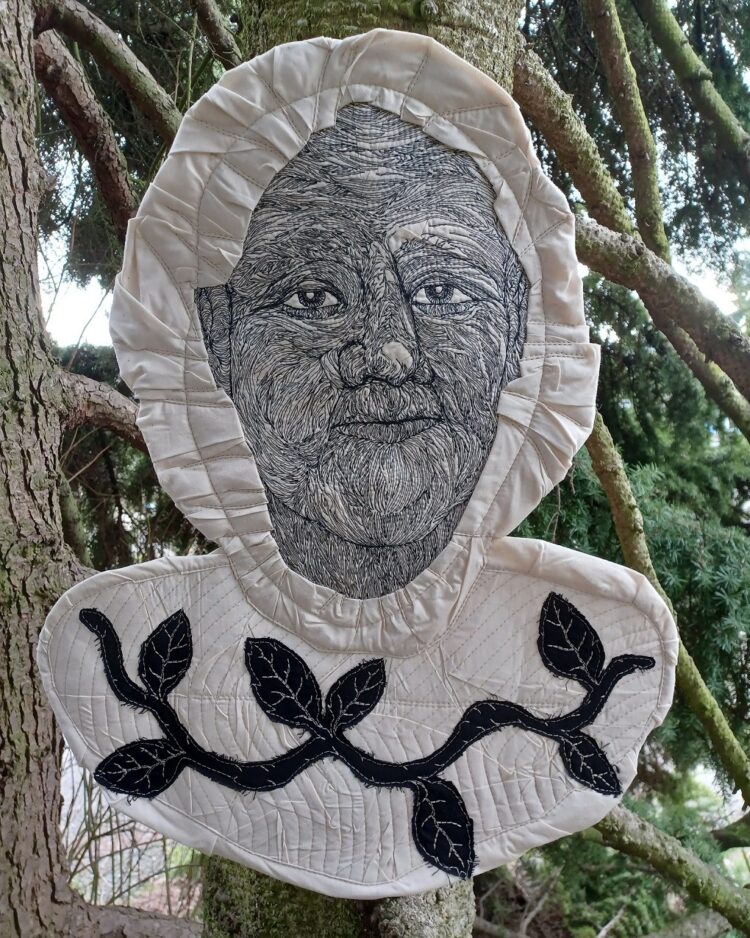
Danny Mansmith began his art career in childhood. He was nurtured by his mum, his great aunt and his grandma who instilled in him the ability to see the creative possibilities in the things around them. Danny’s path wasn’t straightforward, but his self-motivation was key.
Danny Mansmith: ‘I’m an artist who’s kept a conversation going with my sewing machine since the early 1990s. I spent a year at a small art school but I wasn’t very good at following instructions and so I left to teach myself instead. I became inspired to make my own clothes: the idea of looking and dressing in my own style felt important somehow. In the first month, I took apart almost all of my store bought clothes to try to follow the patterns and teach myself about garment construction.
‘Through the years I continued to teach myself how to use the sewing machine. When I finally felt confident, I got my first job sewing for an artist who made baby blankets and accessories.
‘My boss encouraged me to apply for some local art fairs and that was a turning point for me, helping me realise that I could make my way in the world as a working artist.’
‘Making things makes me happy – working with my hands and creating a space where ideas are free to come out and manifest in front of me. The sewing machine is both an inspiration and the tool I use. My home studio is both a sanctuary and workspace, where I keep my love of drawing alive with my daily practice.’
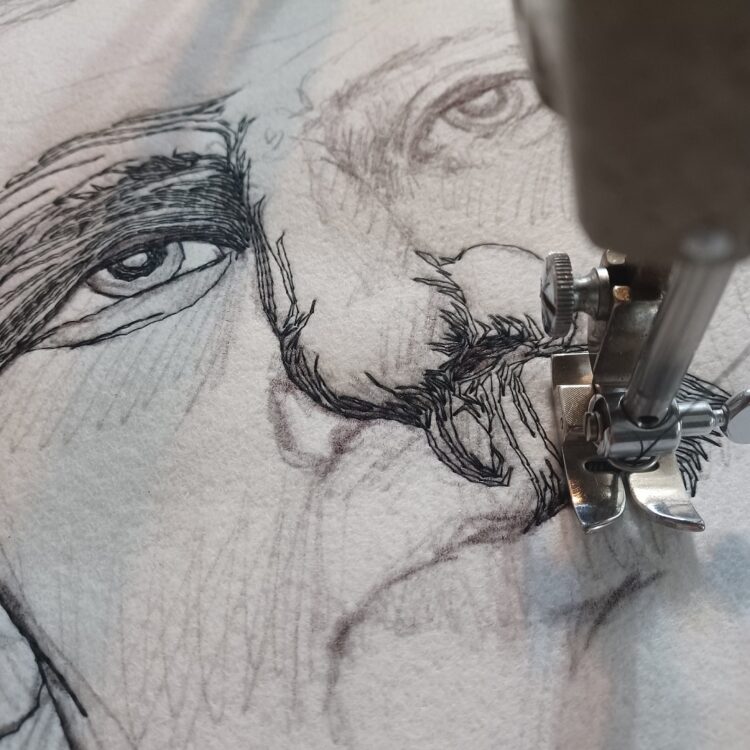
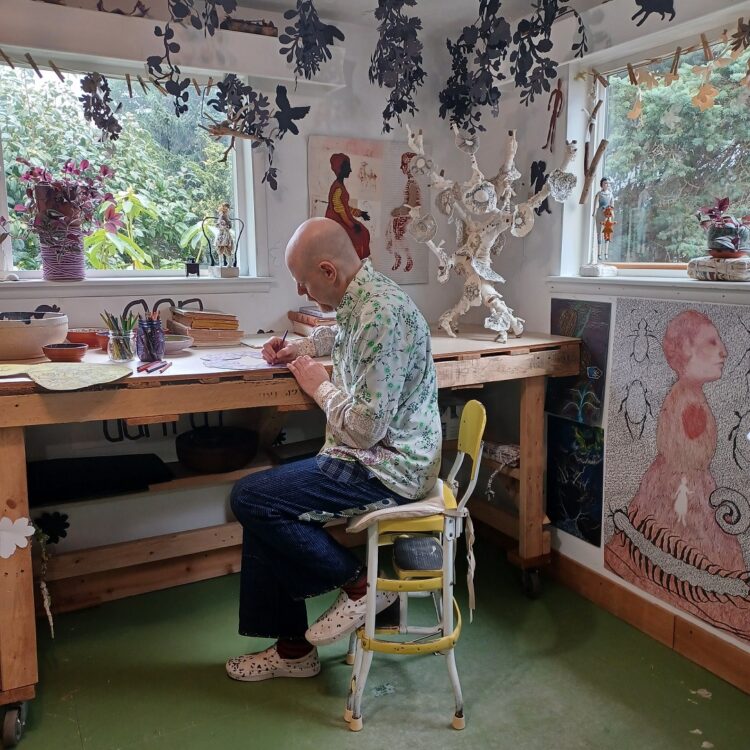
Danny Mansmith is based in Burien, Washington, US and has a strong connection to the midwest and Chicago, Illinois. His solo show ‘We All Become Myth’ exhibited at The Highline Heritage Museum in Burien, Washington, March-April 2023.
Artist website shop: dannymansmith.bigcartel.com
Facebook: facebook.com/danny.mansmith
Instagram: @dannymansmith
Making time each day to create is the secret to a committed and regular practice. Set yourself some boundaries and rules to guide you. This could be 20 minutes a day, or free play, daily sketchbooking, journaling or daily mindful stitching. Be realistic about the time you have available. Small daily actions will help you to overcome resistance and continual action will lead to inspiration and progress.
Your creativity is likely to flow more readily if you can allow yourself space and time without any pressure. Unless you’re working on commissions, don’t try to make art to order, or pressurise yourself to be creating exhibition-worthy art at all times. Every action related to your art is part of your practice – just make sure you treat it with a professional mind-set.
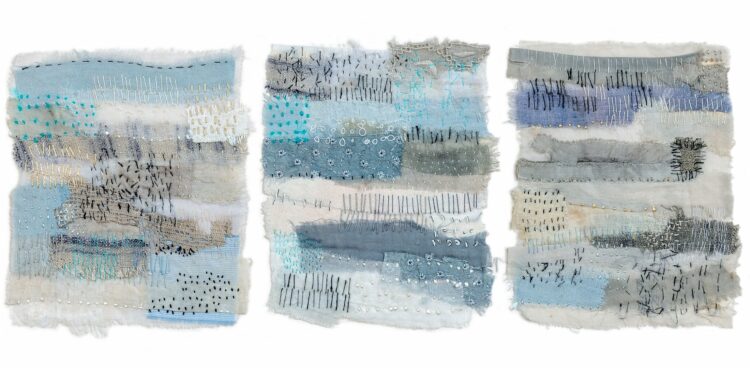
Shelley Rhodes: ‘My daily Instagram posts began as a challenge to make me draw regularly. However, over the years I have shifted slightly, so my post might be a collage, assemblage, printing or mark-making, exploration of materials, a stitch sample, or ongoing work. This habit encourages me to notice and respond, then explore ideas and materials more fully. Some ideas feed into my work, but not always.
‘Sometimes I simply take pleasure in drawing and recording what I see. In 2022, these posts led to an exhibition of my sketchbook pages The Sketchbook at Llantarnam Grange Arts Centre in South Wales. A few years ago, I was asked if I would sell my daily artwork and this has become a great additional source of income. When I post my work online, I never know who is going to see it, or what it might lead to. My daily posts have increased interest in my work, which has led to sales of artwork and books, exhibitions and teaching opportunities.’
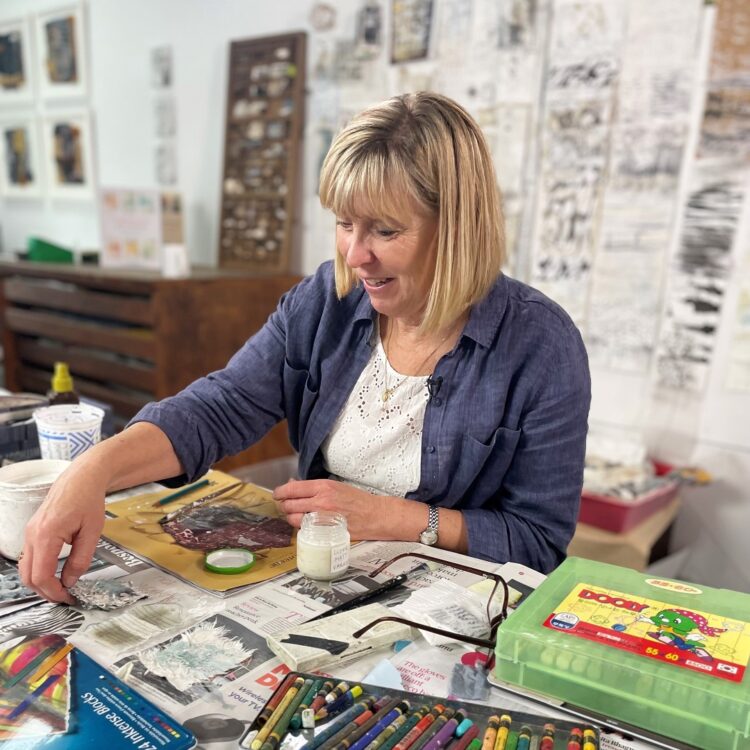
Shelley Rhodes is based on the border between Lancashire and Cumbria, England. She makes mixed media work focusing on fragmentation, reconstruction and repair.
Artist website: shelleyrhodes.co.uk
Facebook: facebook.com/shelleyrhodesmixedmediaartist
Instagram: @shelleyrhodesartist
Having a professional attitude means developing the positive attributes of discipline, persistence and determination. Both Danny and Shelley maintain their commitment with a daily art practice. If you’re feeling an urge to be creative, then allow yourself the time to satisfy it. Set aside time to focus on making art – no matter what. If you make it a priority, rather than an occasional pleasurable activity, then you’ll create a regular practice through your discipline and determination.
But how do you focus? With the plethora of information available on the internet, it’s easy to get bogged down with learning yet more techniques, rather than developing those you know. Guard against this temptation and concentrate on what you’re really interested in.
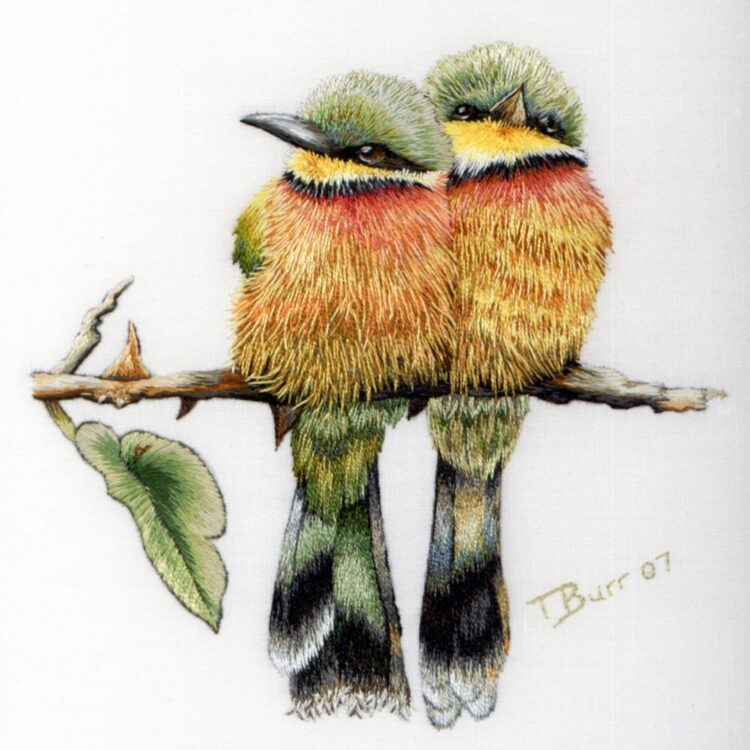
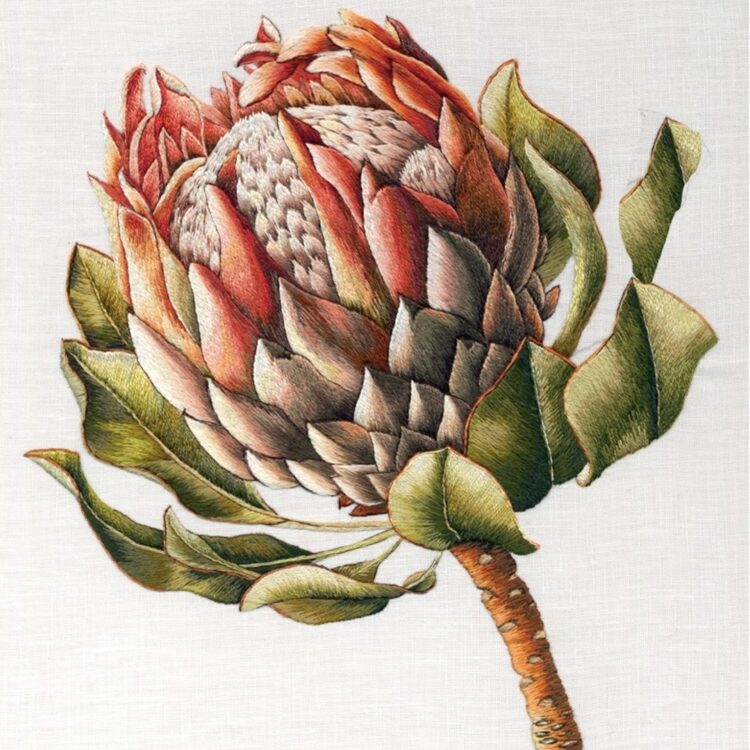
Embroidery artist, educator and author Trish Burr started her craft when she was a young mother in Zimbabwe. She found cross stitch too limiting and so she began to experiment with thread painting. Because patterns and materials were not available and there were drastic foreign currency restrictions, Trish had to use whatever she could find. She chose pictures from books, postcards and calendars, trying her best to replicate them with needle and thread.
Trish Burr: ‘I had no formal training so I created my own style of needle painting – a new form of long and short stitch was born. This simple method, which I have honed and crafted over the years, is what I still use today.
‘When I moved to Cape Town I was asked to teach at some local conventions. My students struggled with the technique and were generally very nervous of it, so I made it my mission to simplify, simplify. I tried to put myself in the shoes of my students – I spent many months with a doodle cloth and notebook, making notes and thinking of different approaches which would make my instructions clear.
‘I think this was a turning point in my career – as my instructions improved, my patterns became more popular, and the demand for my work increased.’
‘Another watershed moment was when I began to explore how colour affected my embroidery. Needle painting is known for its beautiful, shaded appearance, and I wondered why some works looked flat and dull while others had a radiant glow. I spent years researching and experimenting with how colours interacted with each other. I realised that there was a whole world of colour combinations – it was time to break free from traditional limitations.
‘Once, I was trying to recreate the vibrant greens of a bird’s feathers, when a man came to fix our television. It turned out he was an artist. He helped me to understand that you don’t need to use brighter shades of green, but if you create a contrast in the greens it will bring vibrancy. My explorations eventually led me to write the book Colour Confidence In Embroidery.’
Trish’s success can be put down to her determination and focus, which in turn brought about fortuitous events that she could not have made happen. The moral is – begin it!
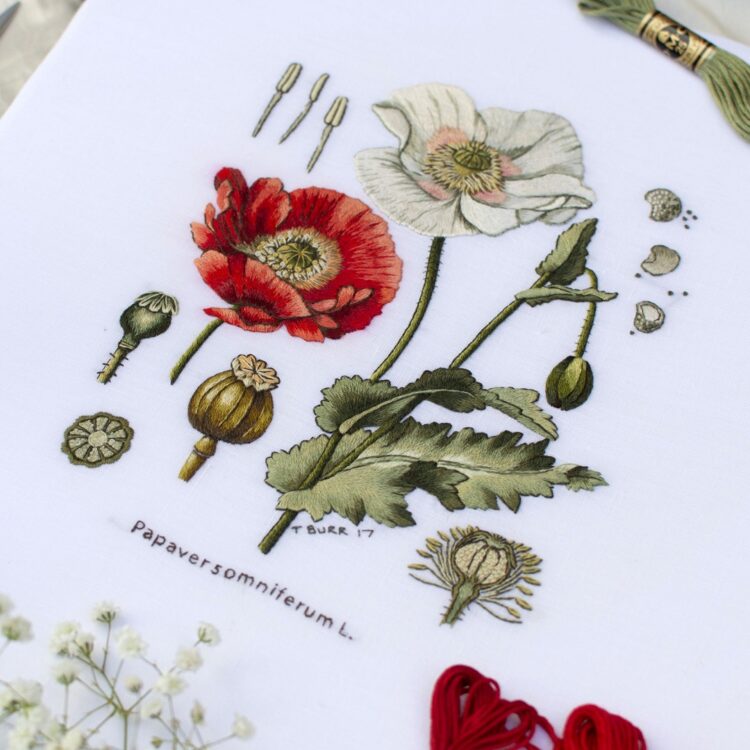
Trish’s challenges did not, however, end there. Trish had to overcome the era of technological revolution, which without determination could have been another cause for procrastination.
‘When I began embroidery, there was no internet, no websites and no online sales. Over the years I had to learn how to manage my own website, produce patterns in different formats for print and PDF, and ship my products worldwide.
‘I purchased the first version of the graphics software CorelDRAW and began to explore drawing my own diagrams and outlines for embroidery. This was life changing for me. I still use the same software program for my designs – I’ve become adept at drawing with a mouse, in fact it now feels awkward to draw with a pencil. I had to get to grips with social media and marketing. When I published my first book I pasted pictures into a spiral bound notebook and manually wrote out the text, but now it is done with computer software and digital photography.
‘It was a constant challenge to juggle my home life with my ever evolving embroidery business, as well as find time to sit quietly and stitch. There came a time when the increased demand was such that I had to choose whether to expand and employ staff, or stay small and personal. I decided on the latter because I wanted time to do what I love, which is to design, stitch and teach. However, I did need some help. The solution came when I attended a talk where the speaker mentioned the benefits of virtual assistants – they handle all the admin, which frees me up to focus on the core work. My assistants in India are always available to help, and I could not do without them!’

Trish Burr is based in Cape Town, South Africa. She is an embroidery artist specialising in needle painting and whitework embroidery. In the last two decades she has published 11 books, created embroidery patterns, tutorials and videos, and has taught both at home and abroad.
Artist website: trishbembroidery.com
Facebook: facebook.com/needlepainting
Instagram: @trishburrembroidery
Much has been written about how to deal with the negative voice in your head.
On her website, artist and author SARK talks about procrastination, as well as the inspiration, motivation and synchronicities that propelled her to success as an artist.
SARK: ‘As someone who has sold over two million books in the last 30 years, it may surprise you to know that I too have experienced procrastination, perfectionism and fears about writing or ever sharing my unique gifts with the world.’
But SARK overcame that to go on to sell her art products and write many inspirational books, including Make Your Creative Dreams Real.
Author Steven Pressfield has written several motivational books including The War of Art: Winning the Inner Creative Battle and Do The Work: Overcome Resistance and Get Out of Your Own Way. He is quoted as saying: ‘Most of us have two lives. The life we live and the unlived life within us. Between the two stands resistance.’
If you struggle with inner blocks, then this idea is worth exploring. As artists and many others have shown, it really is possible to put a stop to resistance.
Internet addiction is a form of procrastination, distracting us from our own work. Do you ever scroll through Instagram while feeling like your work isn’t good enough to share? A great way to overcome perfectionism is by sharing your work, whether that’s on Instagram, Facebook or, like Shelley Rhodes and Sue Stone when they started off, by taking part in a small local exhibition.
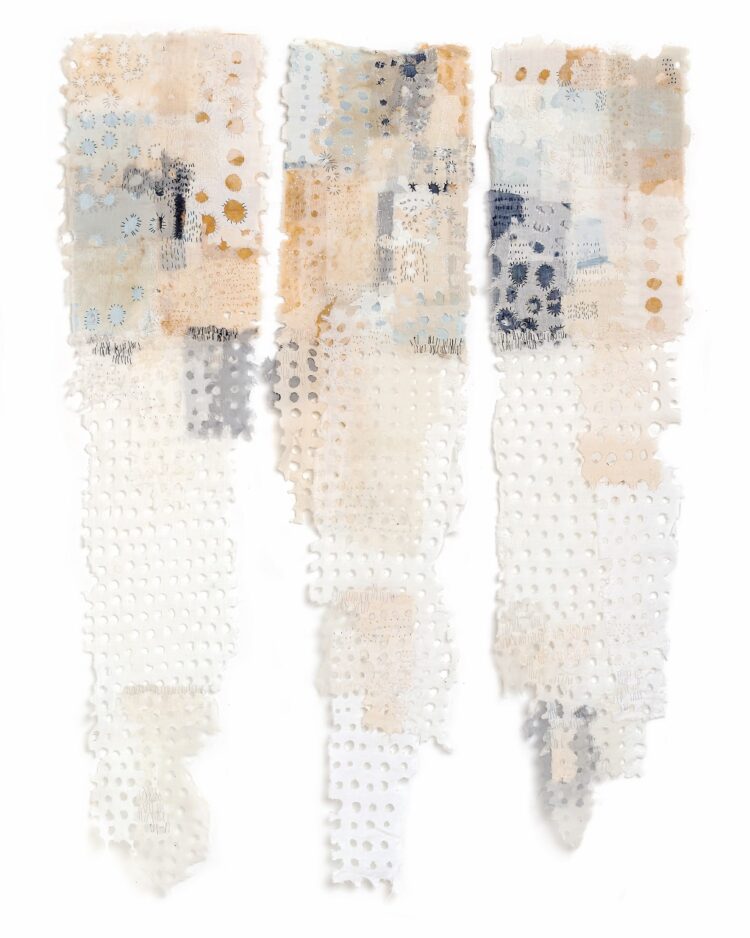
Keeping busy with other things and making excuses is a form of fear that’s often kept under the radar. Do you fear criticism and have low self-esteem, resulting in a feeling of imposter syndrome? Fear can be associated with doing something new, and can stop us in our tracks. But you can use fear as an ally – if you make a start, you will improve and your fears will recede. So take action in spite of fear. As Susan Jeffers wrote in her famous book, feel the fear and do it anyway!
In her motivational book Big Magic: Creative Living Beyond Fear, Elizabeth Gilbert says: ‘Fear is always triggered by creativity, because creativity asks you to enter into realms of uncertain outcome, and fear hates uncertain outcome. This is nothing to be ashamed of. It is, however, something to be dealt with.’
One sure-fire way of overcoming self criticism is to self validate. If you’re not happy with your artwork, figure out what worked, and what would make it better next time. If your attitude towards your practice needs improving, consider what’s holding you back. If you’re not creating enough time, look at what’s stopping you from making your art a priority. Examine your practice and find ways to overcome your blocks. For a quick start to your work sessions, finish each day by preparing for the next. Choose a thread and thread up your needle – then all you need to do is sit down and begin. What could be simpler?
Negative comments can knock your confidence and make you question the validity of your work. Do you fear negative comments from others? If so, try looking at it from another point of view. The people doing the judging may just be trying to provide well-meaning advice, or they could be envious of your work and want to protect themselves. Artists experience many rejections to exhibitions and galleries, so believe in what you’re doing and recognise that selection can be a subjective process. The key is not to over identify with your work – do keep telling yourself ‘you are more than just your art’. If you receive negative feedback, act like a pro and carry on regardless. This attitude will help you to keep going – soon you’ll find that ideas will start to flow.
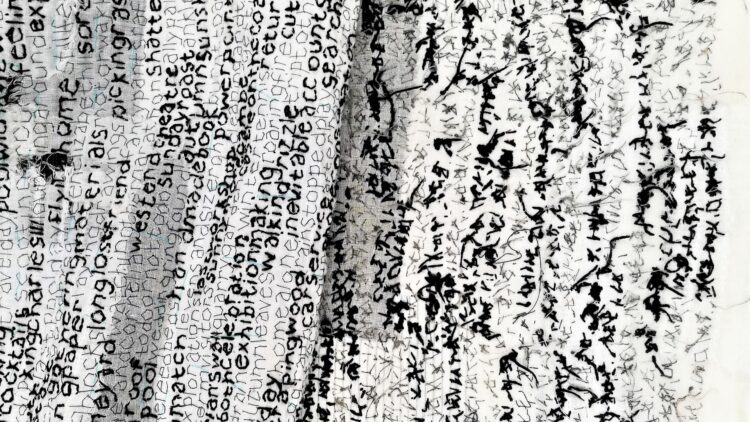
Making art is not a competition, it’s a form of expression, and you should never feel you have to be better than others. We can all make art, and there’s no sense in trying to work your way up an imaginary ‘hierarchy’ of artists.
Remember, making art is unique to you, so create your art for YOU and YOU alone. If you choose to share it on social media, always create the work for its own sake, not for attention or applause.
Shelley Rhodes: ‘It takes a while to develop your own style and way of working, rather than an imitation of others. I always encourage my students to investigate, test materials and explore their own ideas.
‘I try not to make work just because I think it will sell or please others. Rather, I make from
the heart and to please my own artistic values. Having said that, another challenge when starting out on the path to becoming a professional artist can be the lack of money. I gave up full-time teaching to concentrate on my own work, but worked part-time in an administration role while developing my work, as well as teaching my workshops.’
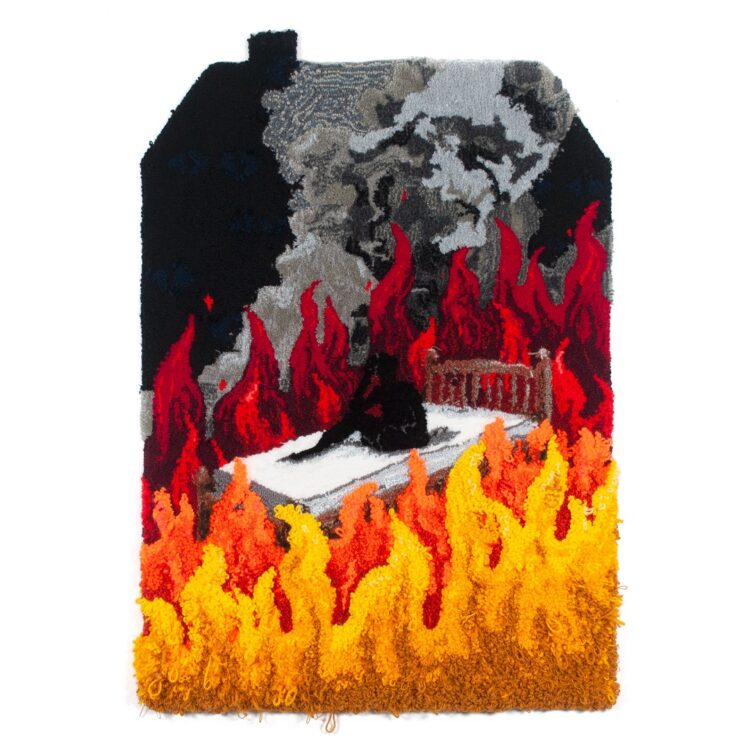
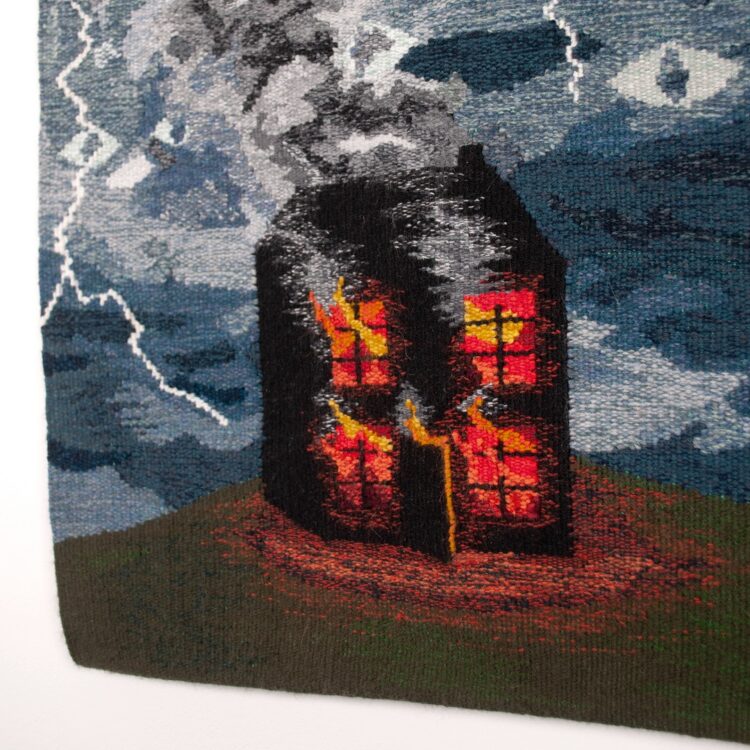
One textile artist who has overcome many challenges is Molly Kent. Molly’s work is concerned with representing issues around mental and physical health through rug tufting and weaving. She focuses on our contemporary existence regarding social media and internet living, and how this affects our perception of self.
In 2018, while at university, Molly had a fall which led to a flashback and a return to ill mental health that had begun when she was 10. She was diagnosed as having complex post-traumatic stress disorder (CPTSD), due to previous trauma.
Molly had experienced bouts of bad nightmares and strange cryptic dreams. As she researched the condition and understood her struggles, she looked into dream psychology. She was able to use these dreams as a visual vocabulary, to construct narratives within her work that allude to the traumas she suffered and her emotional responses to them.
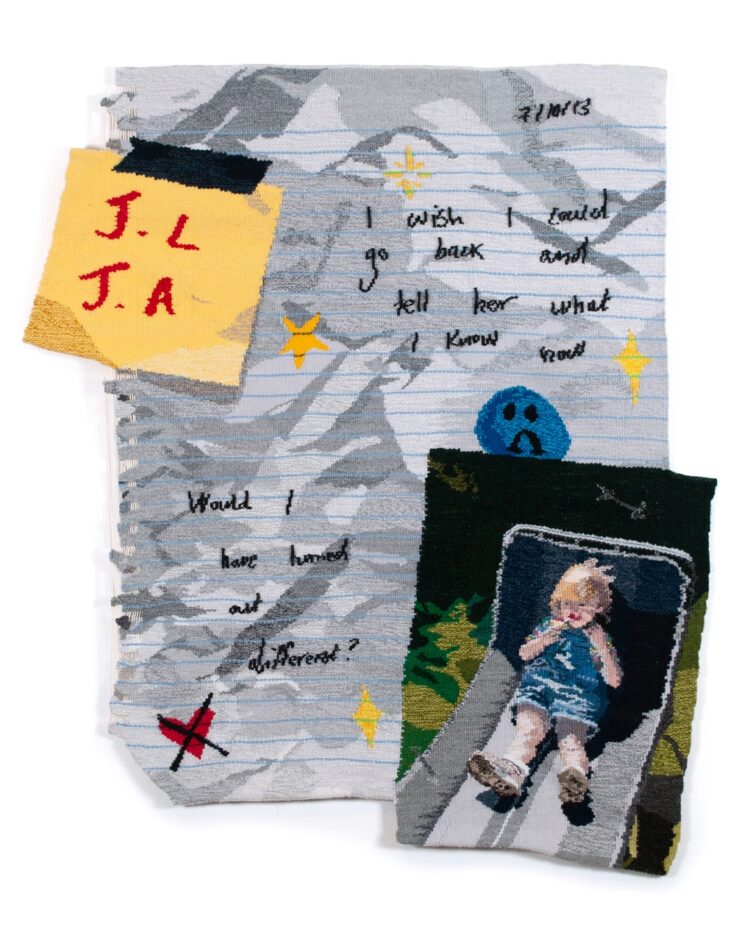
In 2019, her final year of university, Molly produced a body of work Doubt in the Digital Age, which represented her personal doubts within an increasingly digital realm. As the pandemic ensued, her work took on a greater meaning as channels of communication and connection were mostly online. Molly completed her degree and was then furloughed by her employer, so she had more time to focus on making artworks.
It was then that she created Dream Weaving to record her CPTSD-related dreams and nightmares. She developed her tapestry weaving skills, not only to expand her methods of making, but also as a calm and meditative process, compared to the noisy and anxiety-inducing rug tufting process she’d used before.
Molly has a down-to-earth approach to her status as a professional artist – it mirrors the imposter syndrome or sense of fraudulence that some artists feel.
Molly Kent: ‘In all honesty, I still find the label of professional artist to be a strange one, I don’t really know what I’m doing most of the time, and feel like I haven’t really got the hang of being a career artist yet. But, from the outside, I suppose it does look like I’m a professional.
‘My journey hasn’t been linear or even consistent in many ways, most probably due to my mental health. But my CPTSD diagnosis, researching dream psychology and realising the effects of lockdown have propelled my work forwards in terms of the development of the digital aspects of my works.
‘I’m somewhat passive at going out and trying to seize opportunities first hand, so I’m grateful to many others for helping my development as an artist, including award bodies, private and public collectors, and fellow artists who have nominated me for awards or opportunities.’
‘I think the main thing that has helped my progress is simply continuing to create work in the face of multiple adversities, and making work that feels true to me.’
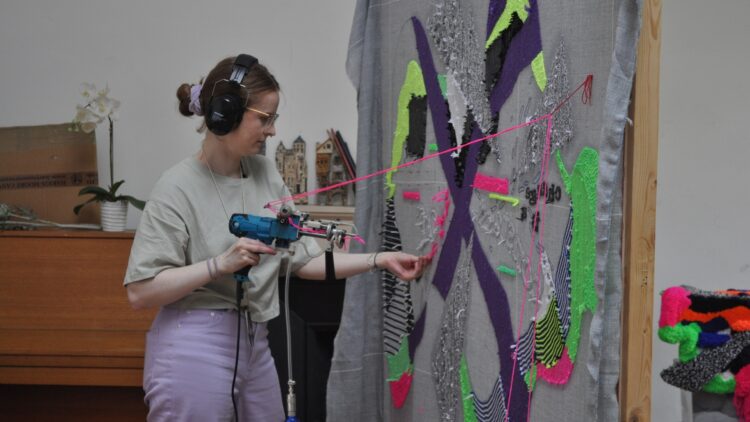
Molly Kent is based in Edinburgh, UK and has a MA from Edinburgh College of Art. Molly has exhibited at the Venice Biennale (2019), and her work has toured with exhibitions in Australia, Scotland and the UK. Her work is held in the University of Edinburgh’s art collection and the National Museum of Australia.
Artist website: mollyhkent.com
Instagram: @mollyhkent
Creating is central to your practice, but artists also have to spend time doing other things to support their work, whether it’s research, testing out techniques, sketchbooking, communicating with others, making applications, administration and accounting, or framing and hanging their work. So it is essential to figure out how to get organised and learn the technical skills you need.
Though these are all important, don’t forget that your key task is to place the focus on your art practice – give your art a high priority, every day.
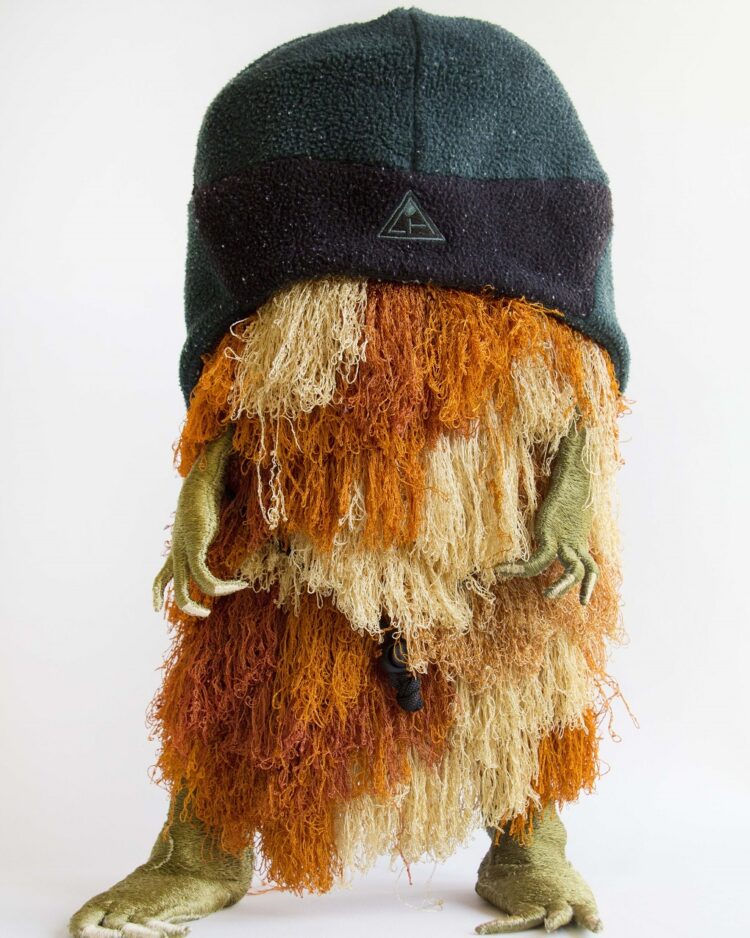
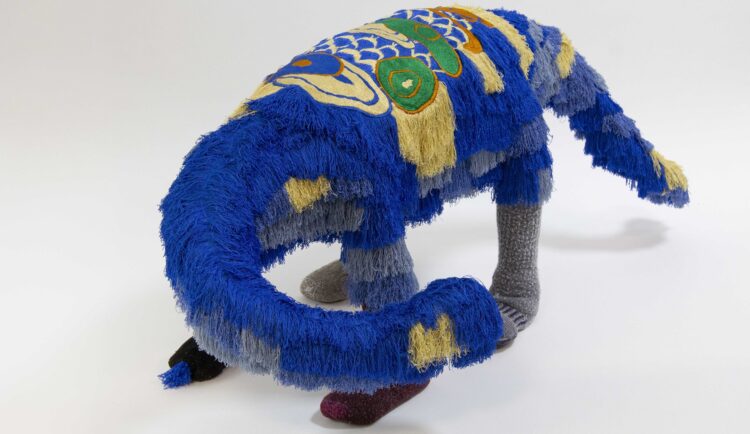
Woo Jin Joo is an award-winning mixed media artist specialising in soft sculpture. Her work challenges the value that humanity endows on objects in a materialist and consumerist society.
When she graduated in 2021 Woo Jin decided to become a professional artist. She felt some trepidation as she faced the responsibilities of balancing time, finances and the other practicalities that go with a career.
Woo Jin Joo: ‘I had initial uncertainties when deciding to be a freelance artist. Throughout my studies, I was completely absorbed in the medium and making – I knew wholeheartedly that my art brings me the most fulfilment. I was unsure about the financial viability of the move and having to navigate a career after being in formal education for so long.
‘However, I was really lucky to be awarded the Janome Fine Art Textiles Award at the Festival of Quilts in 2021, just a few months after graduating – it was exactly what I needed at that moment. It not only showed me that my work is appreciated in the professional world, but also gave me financial support to invest in my own free-hand embroidery machine and studio fees, giving me the extra courage I needed to make the transition.’

Initially, Woo Jin kept on her part-time job as a gallery assistant. She applied for opportunities to lead workshops and fulfil her desire to work in education. After a year or so she was able to leave her part-time job and now works as a freelance workshop facilitator, which helps to support her art practice.
Woo Jin Joo: ‘I always try to prioritise my studio practice but it’s a constant balancing act, with the added task of searching and applying for exhibitions, residencies, commissions and funding opportunities. There are a lot of administrative and miscellaneous tasks taking place behind the scenes to make a studio practice happen, but in the end I’m excited and energised by the fact that I can bring my ideas to life as an artist.’
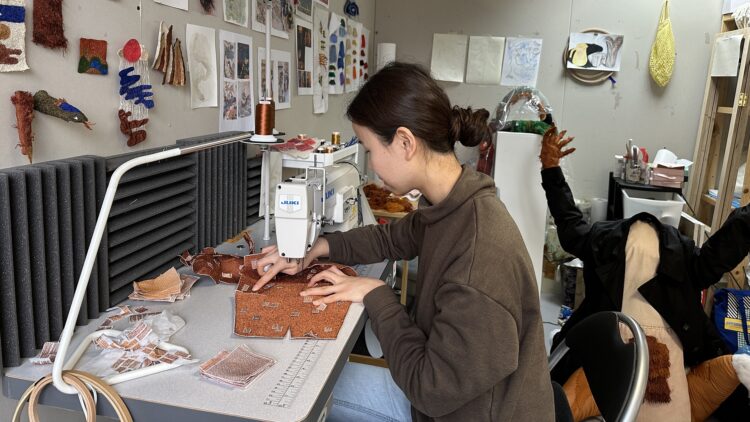
Woo Jin Joo is originally from Seoul, Korea, and moved to London in 2014 to complete a BA Textiles at Central Saint Martins, and an MA in Textiles at Royal College of Art. In 2021, she won the Janome Fine Art Textiles Award, and was shortlisted for Hari Art Prize and East London Art Prize.
Artist website: woojinstudio.com
Instagram: @woojinstudio
Going it alone isn’t always easy, especially if procrastination has been a habit of yours – it can be hard to ditch. You may need encouragement to find the motivation to stick to a routine or get the discipline to put down your phone and stitch.
This is where the benefits of joining a group can be enormous, whether that’s online or in person. When you interact with like minded artists, you begin to feel at home, motivated and supported.
Woo Jin was accepted into the 62 Group as an Associate Member, and Shelley Rhodes joined the Textile Study Group, which bolstered her path to becoming a professional artist.
Shelley Rhodes: ‘Being part of such a respected, national group has helped me to raise the level of my work and to be seen by a national audience. It is a very special textile group, as we work alongside each other on two weekends each year, led by a renowned artist. So I continually learn and develop skills within my practice. Not everything is relevant to what I do, but I think it’s always good to be open to learning and resolving ideas in a new way.
‘The group also requires its artists to teach, which continues to stimulate me and feed into my work. Also, thanks to the generosity of my students, I often learn things when I teach.’
If you want to scale up your textile art practice, then adopting the mindset of a professional artist is a step in the right direction. The artists we’ve interviewed have shared some of their best insights into practical actions you can make.
Danny Mansmith: ‘Use the internet for simple things, like sharing images on Instagram or joining an art group or co-op gallery. Look for like minded people to connect with and share ideas. It takes time to develop all the skills necessary to be a working artist, just keep at it.’
Shelley Rhodes: ‘I believe that one thing often leads to another, so get your work seen and have a presence on the internet, whether that’s through a website or social media. I was first invited to teach in Australia because the organiser saw my work on Pinterest, which subsequently led onto other things. And when I first started out, I had some work in a small local exhibition. A gallery manager saw it, which led to a solo exhibition. I like to let things develop organically over time. Sometimes you have to pursue opportunities, but often they come to you when you least expect it!’
Trish Burr: ‘Don’t hide your light under a bushel! Set aside your self doubts and think about how much pleasure you are giving others by sharing your work. We’re all capable of much more than we realise. We all have a creative sense; it is just a matter of honing our specific craft. Creating something original is one of the most satisfying and rewarding things you can do. No matter how difficult your customers or followers are, always be kind and helpful. They will appreciate it and become your most loyal supporters. Read the book Delivering Happiness by Tony Hsieh. It shows you how to live a life of passion and purpose, while literally delivering happiness to others.’
Molly Kent: ‘Try to consistently make and share what you’re doing, be it via social media, or by talking to fellow artists or curators. I find that people reach out when they’ve seen a new work on my Instagram feed, or through my website, which I update regularly. Also, have a sense of balance – despite being known as a professional artist, I don’t make a living wage from my art. It’s a balancing act: working enough to pay the bills, while leaving enough time to work consistently on my art practice.’
Woo Jin Joo: ‘Find a core narrative, interest and passion to drive and inspire your practice. Take time to rest, reflect and research – it’s not always about constantly producing. If you are looking to make your art your business, then register yourself as a sole trader, get a business bank account, keep a good record of your income and costs, and get public liability insurance. Maintain good working relationships with organisations, galleries, and people you work with. Don’t be afraid to put your work out there, you never know what could come of it.’
Many artists talk about finding a narrative. Reported as being one of the greatest films of all time, The Wizard of Oz is a fantasy containing many metaphors that may be worth remembering as we all tread our paths through life.
When Dorothy reached the end of the yellow brick road she discovered that the wizard she’d sought was an ordinary man who didn’t really hold the power to send her home. Along the way she learnt that she’d already got all the intelligence, heart and courage she needed – the power was within her.
You have that too. So, are you ready to follow your own yellow brick road…?
‘My formula for success was very simple: Do whatever is put in front of you with all your heart and soul without regard for personal results. Do the work as though it were given to you by the universe itself – because it was.’
Michael A. Singer, The Surrender Experiment: My Journey into Life’s Perfection.
We hope you feel inspired to approach your textile art practice with new vigour and that reading the trials, successes and tips from our professional artists has given you some useful pointers. If you’re still wondering where to begin, read our article Getting started with a new piece of work.
If you buy books linked to our site, we may earn a commission from Bookshop.org, whose fees support independent bookshops.
If you feel motivated to take your first step towards a more professional textile art practice, tell us more in the comments below.